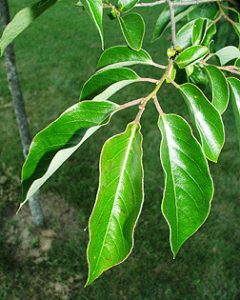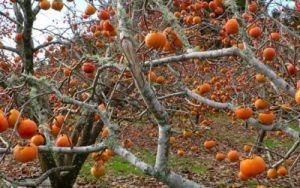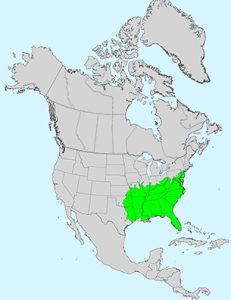Persimmon: The Gift that Keeps on Giving
By Catherine Macaulay, Fairfax Master Gardener Intern
 “Are you still trying to peddle that fruit?” I asked my neighbor, smiling wryly as I stared into the paper bag nearly filled with brightly-colored, orange persimmons.
“Are you still trying to peddle that fruit?” I asked my neighbor, smiling wryly as I stared into the paper bag nearly filled with brightly-colored, orange persimmons.
Such is the giving nature of the American persimmon, a deciduous, moderately sized tree capable of yielding up to 100 pounds of fruit per year when fully mature, becoming in the process, the gift that keeps on giving.
Diospyros virginiana may be a mouthful to say, but when fully ripened, the berried fruit of this native American beauty is simply grand. Adjectives such as: rich, dense, complex and sweet, with just a hint of caramel, describe its edible yields. It is a food source not for only humans, but also for birds, small mammals, white-tailed deer, foxes, raccoons and black bears.
Unlike the more standard fruit bearers such as apple, orange and pear, the American persimmon can withstand a less-than-green thumb, making it a candidate for non-gardening enthusiasts and urban residents. Moist, well-drained sandy soils are ideal, but the tree will also tolerate hot, dry conditions. In the wild, a native persimmon grows in a wide range of environments, thriving in both lowland and upland habitats. It blooms and fruits best in full sun to partial shade.

Persimmon leaves
What the Persimmon requires most from any caretaker is patience. It can take from six to eight years before a tree is able to produce any fruit, depending upon the cultivar. But the yield far exceeds any wait time. Long after other fruit bearing trees are exhausted of their bounty, the sturdy persimmon keeps on producing — from fall into winter.
The American persimmon tree is part of the ebony family. It is known for its erect trunk and beautiful, black corrugated bark that resembles an alligator’s hide. The hardwood of the trees is highly sought after by wood carvers. Its foliage is a striking orange-red in the fall.
Timing is critical when harvesting. An apple picked too early might be small and tart but picking an underipened persimmon and biting into its flesh can make the eyes water, given its high concentration of tannins. “If it be not ripe it will drawe a man’s mouth awrie with much torment,” wrote Captain John Smith of the Jamestown colony. Still, he maintained that the fruit was as “delicious as an Apricocke,” and well worth the effort.
 During the 1770s, America’s pre-eminent botanist, William Bartram, wrote extensively about the Persimmon, which derives its name from the word “putchamin,” meaning dried fruit. George Washington and Thomas Jefferson, both leading horticulturists and agriculturalists of their time, documented the tree’s existence, looking to establish a collective pride in the country’s diverse natural flora. The sight of a persimmon tree standing in a winter field or in a thicket of woods, its bare branches dotted with red-orange berries, was part of America’s seasonal celebrations and holiday menus — its rich, fruity flesh incorporated into recipes ranging from persimmon pudding to cookies, muffins and jams.
During the 1770s, America’s pre-eminent botanist, William Bartram, wrote extensively about the Persimmon, which derives its name from the word “putchamin,” meaning dried fruit. George Washington and Thomas Jefferson, both leading horticulturists and agriculturalists of their time, documented the tree’s existence, looking to establish a collective pride in the country’s diverse natural flora. The sight of a persimmon tree standing in a winter field or in a thicket of woods, its bare branches dotted with red-orange berries, was part of America’s seasonal celebrations and holiday menus — its rich, fruity flesh incorporated into recipes ranging from persimmon pudding to cookies, muffins and jams.
Today’s commercial growers have taken the makings of a colonial food tradition and expanded it significantly by breeding a variety of cultivars that offer large fruit and delicious flavor to an urban populous looking to incorporate healthy foods into their diet.
The American persimmon — how sweet it is.
- Extremely cold-hardy. Survives down to -25°F. (USDA Zones 5-9)

- Generally grows from 30 to 70 feet high, depending upon conditions. Smaller, dwarf varieties make harvesting crops easier.
- Produces its berried fruit between October through mid-December. Different cultivars come into season as early as mid-September and last into February.
- Fruits are roughly 1 to 2 inches in diameter.
- Flowers begin to bloom in May and remain until June.
- The male trees have different flowers than the females. Check with your nursery to see if the variety they’re selling is self-fertile or if it requires cross-pollination, (requiring several trees).
- No known insect or disease problems. Leaf spot may occur.
References
• Common Persimmon, Virginia Tech Dendrology
• Diospyros virginiana, Elisabeth Meyer, North Carolina Extension Plant Toolbox
• American Persimmon, Cheryl Kaiser and Matt Ernst, University of Kentucky Cooperative Extension
Service
• American Persimmon, Fran Steele and Jason Hu, Yale Nature Walk, Yale University
• Common Persimmon, Southern Region, US Department of Agriculture
• Diospyros virginiana, Plant Profile, US Department of Agriculture, Natural Resources Conservation
Service